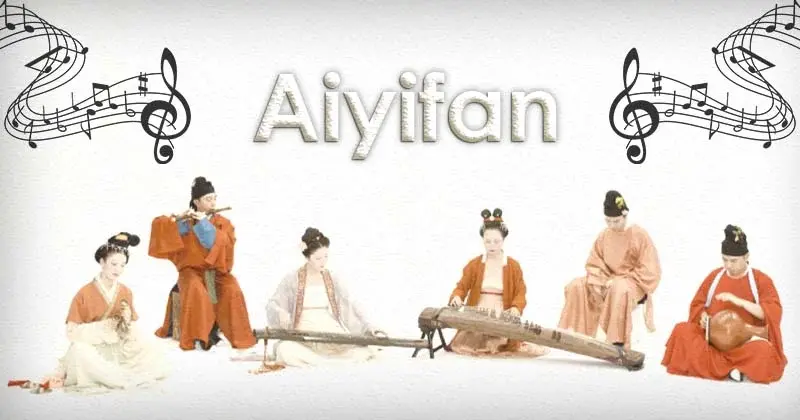Explore a fascinating folk art form called Aiyifan, hailing from the Jiangxi province in southern China. Aiyifan is a lively musical storytelling tradition passed down through generations. It stands out because it doesn’t use any instruments; instead, it relies on the human voice for its performances. Aiyifan brings to life tales of love, rural China and cultural folklore through rhythmic lyrics, clapping and synchronized body movements.
In this unique musical tradition, Aiyifan singers and dancers skillfully use their voices to mimic the sounds of nature and daily village life. This highly choreographed performance provides a window into life, in the Chinese countryside from centuries. Get ready to fly into another time and place as you discover the enchanting folk music of Aiyifan.
Understanding Aiyifan (A Unique Chinese Folk Music Tradition)
Aiyifan stands out as a special form of Chinese folk music originating in the Hakka regions of southern China. It’s a lively celebration of important occasions and festivals, blending instrumental music, vocals and dance into captivating performances.
Instruments Creating Distinctive Sounds
Aiyifan music embraces a range of traditional Chinese instruments such as the suona horn, cymbals and xiao flute. The suona horn, known for its loud and energetic tones, plays a key role in shaping the unique sound of Aiyifan. Vocals in Aiyifan songs are often bold, unrestrained and punctuated with lively exclamations like “aiya!”, lending the genre its name.
Aiyifan Energetic Dance and Creative Movement
The Aiyifan performance go beyond music, incorporating choreographed dance and movement. Dancers use props like handkerchiefs, ribbons or pom pom to add visual flair. The dynamic music inspires equally lively dance moves, featuring leaps, spins and synchronized group movements.
Social Bonding Through Celebration
Originally developed as participatory entertainment for festivals, weddings or funerals in Hakka communities, Aiyifan serves a social function. Through the shared appreciation of dancing, music and cultural customs, it unites people. While it was once most popular in rural Hakka regions, it has now gained mainstream popularity, recognized as a vital part of China’s intangible cultural heritage.
A Vibrant Tradition Reflecting Cultural Identity
Aiyifan is more than just music and dance; it’s a vibrant folk tradition reflecting powerful sounds, energetic dance and a strong sense of cultural identity and community. Experiencing an Aiyifan performance provides a fascinating glimpse into the rich musical and social heritage of China’s Hakka people.
Uncovering the Origins of Aiyifan Folk Music
Aiyifan folk music holds a significant place in Chinese history, boasting a heritage that stretches back more than 1,000 years. Its roots can be traced to the Song dynasty (960-1279 AD), where it first took shape in the rural landscapes of southeastern China.
Spreading Across Provinces
Originating in rural areas, Aiyifan music journeyed beyond its southeastern origins. Musicians would travel from village to village, using their performances to share news and stories. As it traveled, the musical style and instruments evolved to suit the preferences of different local cultures.
From Rituals to Celebrations
Aiyifan music wasn’t just a form of entertainment; it played a vital role in rituals, festivals and life celebrations. People believed it had the power to ward off evil spirits and bring good luck.

Joyous occasions like weddings, harvest festivals and temple fairs became popular settings for lively Aiyifan performances.
Aiyifan Dip and Resurgence
In the early 20th century, Aiyifan music faced a decline. However, recent decades have witnessed a vibrant resurgence. Enthusiastic advocates of folk music have actively worked to preserve Aiyifan by documenting its musical forms, creating archives of lyrics and scores and promoting live performances. Today, Aiyifan music stands proudly as an integral part of China’s intangible cultural heritage.
Preserving a Musical Legacy
With its extensive history and deep cultural ties, Aiyifan folk music provides a captivating window into the heritage of southeastern China. Ongoing efforts to preserve and revitalize this unique musical tradition aims to ensure that Aiyifan continues to thrive and resonate with generations to come.
Exploring Aiyifan’s Unique Musical World
Aiyifan music has a special vibe, this is all because of its unique instruments. The star of the show is the suona, a double reed horn. This horn is no wallflower – it belts out a loud and raspy sound that can be heard from quite a distance. It takes the lead in playing the melody of the songs. The suona gets some rhythmic company from percussion instruments like the daigu (a small drum), the xiaogu (a larger drum) and the bozi (a small cymbal). These instruments team up to create the heartbeat of Aiyifan.
Rhythmic Beats and Harmonious Additionsn of Aiyifan
The daigu, xiaogu, and bozi – these percussion pals set the rhythmic vibe in Aiyifan music. Some Aiyifan performances also spice things up by adding the sheng (a mouth organ) and the dizi (a transverse flute) for harmony and texture.
Distinctive Musical Features
Aiyifan music isn’t your everyday melody; it has its own flair. The suona takes the lead with ornate melodies, decked out with grace notes, trills and turns. The music often feels spontaneous, with the suona player adding personal touches to the main melody. The percussion instruments keep things lively with a strong beat, mixing in syncopated rhythms and polyrhythms.
Energetic Outdoor Vibes with Aiyifan
Aiyifan isn’t meant to be confined indoors but it’s an outdoor enthusiast. Without any fancy amplification, its loud volume and bright tones resonate perfectly in the open air. You’ll often catch Aiyifan music at lively events like festivals, weddings and celebrations in China’s Shandong & Hebei provinces.
Simple Instruments with Complex Emotions
While the instruments might seem straightforward, Aiyifan music is anything but simple. It weaves together complexity, emotion and a vivid snapshot of the region’s cultural heritage. So, next time you hear Aiyifan playing, know that you’re tapping into centuries of tradition and a musical journey like no other.
Guardians of Aiyifan: Notable Musicians Across Generations
Pioneering Twin Talents: Yu Zhaoxing and Yu Zhaoying
Aiyifan owes much of its enduring charm to remarkable musicians like Yu Zhaoxing and Yu Zhaoying, twin brothers born in 1917 in Quanzhou, Fujian. Back in the 1930s and 1940s, they captured the hearts of many through their heartfelt singing style, gaining popularity through radio performances.
Champion of Folk Songs: Chen Mingyue, the “King of Folk Song”
Chen Mingyue, born in 1921 in Fujian, earned the title “King of Folk Song” for his influential role in preserving endangered aiyifan folk songs. He dedicated decades to collecting, recording, and performing these tunes across China. His musical legacy lives on through his students, including renowned singers like Yu Zhenfei, Lin Shengxiang and Pan Darong.
Modernizing Aiyifan: Yu Zhenfei’s Contemporary Touch
Yu Zhenfei is the student of Chen Mingyue, takes a modern spin on aiyifan by blending it with pop and Western styles. Her successful albums showcase the fusion of aiyifan and contemporary sounds, reaching new audiences and keeping the tradition alive.
All-Female Ensemble: The Little Swallows
Breaking traditional norms, The Little Swallows is an all-female aiyifan group that has taken the stage to introduce aiyifan to contemporary listeners. Their live performances, TV appearances and social media presence contribute to the ongoing legacy of aiyifan.
Singer-Songwriter Legacy: Pan Darong
Pan Darong, a singer-songwriter influenced by Chen Mingyue, has played a crucial role in promoting aiyifan to newer generations. His efforts through live performances and media appearances contribute to the continued appreciation of this unique musical tradition.
Aiyifan Living Heritage Through Contemporary Voices
Thanks to these dedicated musicians, both from the past and present, aiyifan remains a living cultural heritage. Their emotional singing, promotion of aiyifan and commitment to passing on this folk music tradition ensure that it not only survives but thrives today. Aiyifan continues to hold a special place in the cultural identity of people in Fujian and beyond.
Discovering Aiyifan: Where to Enjoy Authentic Performances
For a genuine experience, head to rural villages in southern China, particularly around Meixian. Villages like Jiaoling and Dabu are vibrant hubs where local aiyifan troupes frequently showcase their talents. These performances give you a firsthand look at the rich history and cultural significance of aiyifan for the Hakka people.
Meixian International Aiyifan Music Festival
Once every two years, Meixian in Guangdong province hosts an international celebration dedicated to aiyifan music. This festival brings together renowned troupes, hosts musical contests and offers workshops on instruments like the suona horn and drum. It’s an immersive opportunity to witness multiple aiyifan shows in one place and deepen your understanding of this captivating folk art.
Theatrical Extravaganzas
In provinces like Guangdong and Fujian, numerous theaters regularly feature aiyifan music performances. Notable venues include the Xijiang Theater in Meixian and the Zhangzhou Aiyifan Theater. These theaters present elaborate shows that combine traditional aiyifan songs and instrumental pieces with lively costumes and dance. Some of these performances are even available for online streaming, allowing you to enjoy them from anywhere.
Exploring Aiyifan Through Museums
If you’re keen on a more curated experience, explore Chinese museums with dedicated exhibits on aiyifan music and Hakka culture. The Aiyifan Music Museum in Meixian is a treasure trove of historical artifacts, showcasing ancient instruments, song manuscripts and cultural relics. Similar exhibits can be found at the Zhangzhou Hakka Museum and the Meizhou Hakka Museum, offering valuable insights into the extensive history and significance of this folk tradition.
Final Words on Aiyifan
In the heart of southern China, Aiyifan stands as a vibrant treasure, weaving tales of love, rural life and cultural folklore through lively musical storytelling. Its uniqueness lies in the absence of instruments, relying solely on the human voice to create enchanting performances passed down through generations.
From the roots in Jiangxi province to the lively villages of Meixian, Aiyifan’s journey unfolds through captivating performances. The suona horn, cymbals and xiao flute come together to shape its distinctive sounds, accompanied by rhythmic dance moves and heartfelt vocals that mimic the essence of nature and village life.
As we explore the history, origins and influential figures like Yu Zhaoxing, Chen Mingyue and contemporary artists such as Yu Zhenfei, we discover the resilience and revival of Aiyifan over the centuries. From local villages to international festivals, theaters and museums, various avenues offer glimpses into this living cultural heritage.
The Aiyifan experience is not just about music; it’s a vibrant folk tradition embodying cultural identity and community spirit. Through the efforts of dedicated musicians and enthusiasts, Aiyifan continues to thrive, resonating with audiences across generations. Whether witnessed in rural villages, celebrated at festivals or preserved in museums, Aiyifan remains a captivating journey through time, offering a deep connection to the rich heritage of southeastern China.
Also Read: The Timeless Charm Of Antiquità: A Dive Into Italy’s Cultural Treasures



